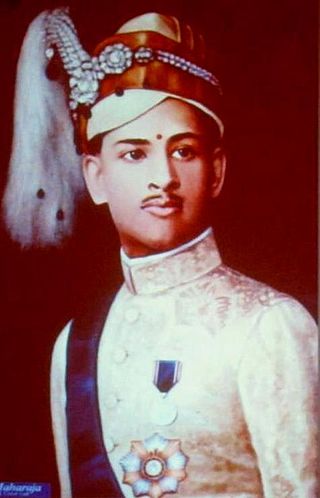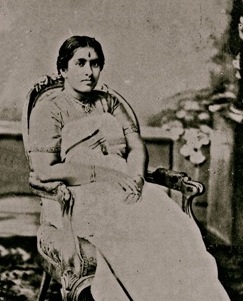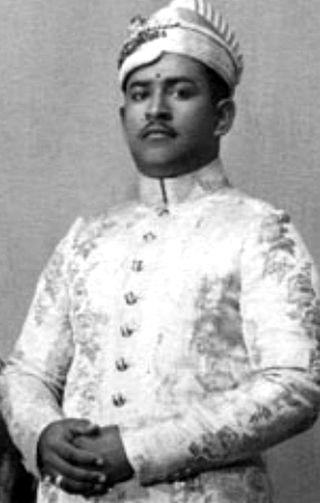
The Kingdom of Travancore, also known as the Kingdom of Thiruvithamkoor, was an Indian kingdom from c. 1729 until 1949. It was ruled by the Travancore Royal Family from Padmanabhapuram, and later Thiruvananthapuram. At its zenith, the kingdom covered most of the south of modern-day Kerala and the southernmost part of modern-day Tamil Nadu with the Thachudaya Kaimal's enclave of Irinjalakuda Koodalmanikyam temple in the neighbouring Kingdom of Cochin. However Tangasseri area of Kollam city and Anchuthengu near Attingal in Thiruvananthapuram were parts of British India.

Sree Padmanabhadasa Sree Chithira Thirunal Balarama Varma, popularly known as Sree Chithira Thirunal, was the last ruling Maharaja of the Indian princely state of Travancore, in southern India until 1949 and later the Titular Maharajah of Travancore until 1991. His reign is known for several notable reforms that have indelible impact on the society and culture of Kerala.

The Kingdom of Cochin, named after its capital in the city of Kochi (Cochin), was a kingdom in the central part of present-day Kerala state. It commenced at the early part of the 12th century and continued to rule until 1949, when the monarchy was abolished by the Dominion of India.

Irinjalakuda is a municipal town in Thrissur district, Kerala, India. It is the headquarters of Irinjalakuda Revenue Division, Thrissur Rural Police and Mukundapuram Taluk. After Thrissur, this town has most number of administrative, law-enforcement, and judicial offices in the district. The place is well known for Koodalmanikyam Temple and the Thachudaya Kaimals, who had princely status until 1971. The earliest recorded history of this temples date back to the ninth century of Common Era (CE).
The Temple Entry Proclamation was issued by Maharaja Chithira Thirunal Balarama Varma on November 12, 1936. The Proclamation abolished the ban on the so-called 'low caste people' or avarnas from entering Hindu temples in the Princely State of Travancore, now part of Kerala, India.

Koodalmanikyam Temple is a Hindu temple in Irinjalakuda Municipality, Thrissur district, Kerala, India. The temple comprises a main structure, a walled compound with citadels, and four ponds around the main structure one of which is within the walls. Koodalmanikyam Temple is the only ancient temple in India dedicated to the worship of Bharata, the second brother of Rama, however the idol is that of god Vishnu. "Sangameshwara" is another name associated with the deity at Koodalmanikyam. The temple is one of four in Kerala that form a set called "nalambalam", each temple dedicated to one of the four brothers in the epic Ramayana: Rama, Bharata, Lakshmana and Shatrughna.

The Maharaja's College is a government college of higher education located in Ernakulam, Kerala. Established in 1875, it is one of the oldest colleges in India. Located in the heart of the city, the college is spread over a campus of 100,000 square metres on the banks of Vembanad Lake. Blanketed by tall and rare species of trees, its campus features is a mix of old and modern architecture and covers a total area of 19,525 m2 (210,170 sq ft), providing infrastructural facilities for the 22 departments of the college.
Kaimal is an aristocratic title that was historically used by various chiefs from the Nair caste during the feudal period of what is now the Indian state of Kerala. The Kaimals are one of the highest caste of Hindus in Kerala and South India in general. It was the title awarded to notable Samanthan and Kiryathil Nair families. Various families have used the title, including the Kaimals of Koratti, Angi and Koddachery.
Jenmi or janmi is the term used to refer to the landed aristocracy of Kerala who traditionally held their lands as absolute and allodial owners, with such lands known as jenmom or janmam. They formed the landowning nobility as well as the landed gentry of the region in colonial times, and the majority of the estates and feudal properties were owned by this community. They predominantly belonged to the Nambudiri and Nair castes, and it was not unusual for an aristocratic family to own up to 20,000 acres (81 km2) of land. Although many smallholders existed within the janmi system, janmam lands were heavily concentrated into a few dozen families, most of them of royal, high Nair, or Nambudiri Brahman rank. The twenty-two families paying 3,000 rupees or more in land revenue to the Crown, for example, held 620,012 acres among them; the Vengalil dynasty alone accounting for 200,000 acres, followed immediately by the Mannarghat and Kavalappara Moopil Nairs, whose respective swaroopams governed 180,000 acres and 155,358 acres.

Pooradam Thirunal Sethu Lakshmi Bayi CI was the monarch, though designated as the Regent due to British policy, of the Kingdom of Travancore in southern India between 1924 and 1931. She, along with her younger cousin, Moolam Thirunal Sethu Parvathi Bayi, were adopted into the Travancore royal family and were the granddaughters of the celebrated painter, Raja Ravi Varma.
Devaswom are socio-religious trusts in India, whose members are nominated by the government and community. They oversee Hindu temples and their assets to ensure their smooth operation in accordance with traditional rituals and customs. The devaswom system notably exists in the state of Kerala, where most temples are either managed by Government of Kerala-controlled devaswoms or private bodies or families. The properties of each temple are deemed to be the personal property of the presiding deity of the temple, and are managed through a body of trustees who bear allegiance to that deity.

Sree Padmanabhadasa Sree Uthradom Thirunal Marthanda Varma was the titular Maharaja of Travancore. He was the younger brother of the last ruling monarch of the Kingdom of Travancore, Maharajah Chithira Thirunal Balarama Varma.

Akkamma Cherian was an Indian independence activist from Travancore (Kerala), India. She was popularly known as the Jhansi Rani of Travancore.

Kiryathil Nair or Kiriyath Nair is a Kshatriya Nair subcaste, of martial nobility, having performed the functions of Kshatriyas in Kerala, India. This subcaste was among the highest-ranking subcastes of the Nair community along with Samantan Nairs with whom they share a close history. They constituted the ruling elites (Naduvazhi) and feudal aristocrats (Jenmimar) in the regions of Malabar and Cochin in present-day Kerala, India, and have traditionally lived in ancestral homes known as Tharavads and Kovilakams.
Madampi(equivalent to Lord in English) is an aristocratic title given to the uppermost subdivisions of Nairs in Kerala, by the Maharajahs of Travancore and Cochin. Usually, it was given in addition to the Pillai title. Madampis served as Jenmis or landlords during the pre-independence era. Their power was severely reduced after the Communist government passed the Land Reforms Ordinance. The title Madampi was also used in Cochin, to denote the 71 Nayar chiefs who ruled under the Maharajah of Cochin. A few Nambuthiri landlord families, most notable of whom being those in Vanjipuzha and Makilanjeri, were also given the Madampi title. In Cochin, the Madampis had their own armies, but seldom numbered more than 100. Their power was only a little bit higher than that of the Desavazhis. Madampis supplied chieftains along with soldiers in times of war to the King.

The Government Law College, Ernakulam, also known as His Highness the Maharajas Government Law College, Ernakulam is an prestigious institution for undergraduate and post-graduate legal education in Kochi, Kerala, India. Founded in 1874, it is the first law college in the state of Kerala and one of the oldest law colleges in India. The Campus is situated on the banks of Vembanad Lake and is near to Marine Drive and High Court of Kerala. Blanketed by tall and rare species of trees, its campus features a mix of old and modern architecture. The college is recognised by Bar Council of India and affiliated to the Faculty of Law, Mahatma Gandhi University in Kottayam and is a reputed Research Centre in Law. The college’s prestigious alumni includes former Chief Justice of India K. G. Balakrishnan, Noted Indian actor Padma Shree Mammootty, former Defence Minister of India A. K. Antony, and former Chief Minister of Kerala Oommen Chandy. It is popularly known as Ernakulam Law College or Maharajas Law College.

Pillai, meaning Prince, is a title of nobility which can either refer to a ruling chief, members of the nobility, or junior princes of the royal family historically ranked immediately below the king. The oldest lineages of Pillais include not only Kshatriyas but also brahmins who took up the sword. From the early modern period, the title also came to be bestowed upon Savarna subjects by the King of Travancore for services military or political, most of whom were of Nair origin.
M. R. Ry. Kumar Aiyappan Pillai was an Indian lawyer, politician and writer. As one of the early leaders of the Bharatiya Janata Party, he served as its vice-president and at various times as chairman and treasurer. By the time of his death aged 108, he headed the party's disciplinary committee, oversaw its charitable endowments, and had become a most respected and venerable figure in the socio-cultural arena.












